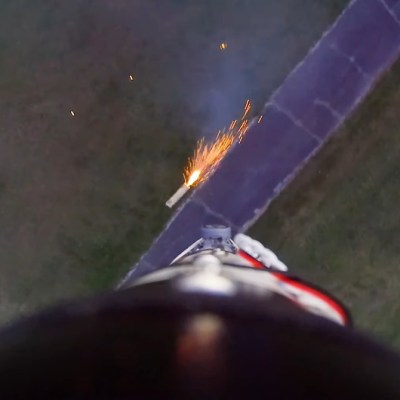So Close to Landing a Model Rocket on Its Tail
We’ve become so used to seeing SpaceX boosters land themselves back on the pad with clockwork reliability, that it’s easy to forget it took them a good number of attempts to get right. Inspired by SpaceX’s work, [Joe Barnard] of [BPS.Space] started working to replicate it at the model scale five years ago, with no engineering education or experience. On the latest attempt with a brand-new thrust vectoring Scout E rocket, he has gotten tantalizingly close to doing a controlled propulsive landing with a solid-fuel rocket motor.
We’ve all been thrilled to see the SpaceX rockets return to earth, landing elegantly on a floating pad. But those are liquid-fueled. The trick with a solid-fuel rocket motor is it can’t be throttled directly, which is a challenge when you need precision control to land. Thanks to [Joe]’s custom AVA flight computer and the remarkably consistent thrust curve of the Estes F15 black powder motors he used, it becomes a matter of igniting the descent motor at the right moment to make the vertical velocity zero at touchdown. However, [Joe] found that the time between sending the ignition signal and when peak thrust is reached was inconsistent, so he had to work around that. He did this by controlling how much of the thrust is spent in the vertical direction, by vectoring the motor side to side to spend some trust horizontally.

In this attempt, the rocket tipped over on landing due to excessive horizontal movement at touchdown. Joe tracked the cause down to a weak GPS signal caused by antenna position and a possible bug in the Kalman filter that fuses all the sensor data for position and velocity estimation. Thanks to incredibly detailed telemetry and logging done by the flight computer, data from every launch are used for future improvements. We are looking forward to the next flight in a few weeks, during which [Joe] plans to tune and test the control software, among other minor improvements.
Almost every single part of this rocket is a display of engineering ingenuity. The landing struts are designed to absorb as much impact as possible without bouncing while being light and quick to deploy. The ascent motor is ejected simply by moving the thrust vectoring mount to one of its extremes, allowing the descent motor to drop into place. The rocket also features a complete emergency abort system with a parachute, which can be activated manually, or by the flight computer if it calculates that landing isn’t feasible. We already covered [Joe]’s latest launch pad, which is a very interesting project all by itself.
from Blog – Hackaday https://ift.tt/2JeIybB
Comments
Post a Comment